
A folk costume expresses a national identity through clothing or costume, which is usually associated with a specific region or period of time in history. It can also indicate social, marital, or religious status. If the costume is used to represent the culture or identity of a specific ethnic group, it is usually known as ethnic costume. Such costumes often come in two forms: one for everyday occasions, the other for traditional festivals and formal wear. The word "costume" in this context is sometimes considered pejorative due to the multiple senses of the word, and in such cases "clothing", "garments" or "regalia" can be substituted without offense.

A kaftan or caftan is a variant of the robe or tunic. Originating in Asia, it has been worn by a number of cultures around the world for thousands of years. In Russian usage, kaftan instead refers to a style of men's long suit with tight sleeves.

African clothing is the traditional clothing worn by the people of Africa.

The culture of Nigeria is shaped by Nigeria's multiple ethnic groups. The country has 527 languages, seven of which are extinct. Nigeria also has over 1,150 dialects and ethnic groups. The three largest ethnic groups are the Hausas that are predominantly in the north, the Yorubas who predominate in the southwest, and the Igbos in the southeast. There are many other ethnic groups with sizeable populations across the different parts of the country. The Kanuri people are located in the northeast part of Nigeria, the Tiv people of north central and the Efik-Ibibio are in the south South. The Bini people are most frequent in the region between Yorubaland and Igboland.

The dashiki is a colorful garment that covers the top half of the body, worn mostly in West Africa. It has formal and informal versions and varies from simple draped clothing to fully tailored suits. A common form is a loose-fitting pullover garment, with an ornate V-shaped collar, and tailored and embroidered neck and sleeve lines. It is frequently worn with a brimless kufi cap and pants. It has been popularized and claimed by communities in the African diaspora, especially African Americans.
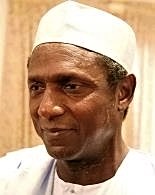
A kufi or kufi cap is a brimless, short, and rounded cap worn by men in many populations in North Africa, East Africa, West Africa, South Asia, and the Middle East. It is also worn by men throughout the African diaspora. The cap has strong associations with many Islamic cultures and pan-African pride. In the United States and the United Kingdom, it is also called a "taqiyah".

Cameroon has a rich and diverse culture made up of a mix of about 250 indigenous populations and just as many languages and customs. The country is nicknamed "Little Africa" as geographically, Cameroon consists of coastline, mountains, grass plains, forest, rainforest and desert, all of the geographical regions in Africa in one country. This also contributes to its cultural diversity as ways of life and traditional food dishes and traditions vary from geographical region to geographical region.
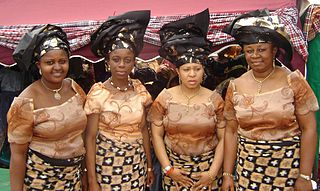
The wrapper, lappa, or pagne is a colorful garment widely worn in West Africa by both men and women. It has formal and informal versions and varies from simple draped clothing to fully tailored ensembles. The formality of the wrapper depends on the fabric used to create or design it.
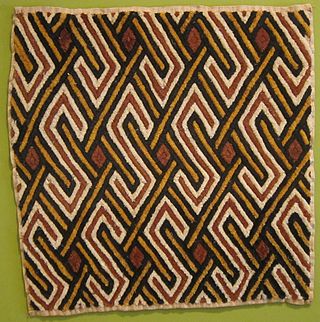
African textiles are textiles from various locations across the African continent. Across Africa, there are many distinctive styles, techniques, dyeing methods, and decorative and functional purposes. These textiles hold cultural significance and also have significance as historical documents of African design.

Chinese clothing includes the traditional hanfu and garments of ethnic minorities, as well as modern variations of indigenous Chinese dresses. Chinese clothing has been shaped through its dynastic traditions, as well as through foreign influences. Chinese clothing showcases the traditional fashion sensibilities of Chinese culture traditions and forms one of the major cultural facets of Chinese civilization.

Aso oke hat, known as fila in the Yoruba language, is a soft hat traditionally worn by the Yoruba people of Western Africa. It is made of hand-woven aso oke fabric, cotton, velvet, or damask. They are usually lined with cotton, but can be unlined if crafted to be worn for a single event.

Aso oke fabric, is a hand-woven cloth created by the people of iseyin in your state Nigeria in the 1500s. Usually woven by men and women, the fabric is used to make men's gowns, called agbada and hats, called fila, as well as women's wrappers, called iro and head tie, called gele.
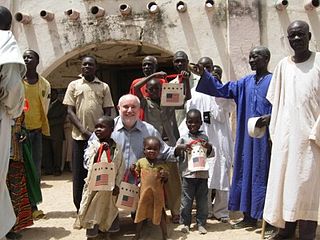
A Senegalese kaftan is a pullover men's robe with long bell sleeves. In the Wolof language, this robe is called a mbubb or xaftaan and in French it is called a boubou. The Senegalese caftan is an ankle length garment. It is worn with matching drawstring pants called tubay in Wolof. Normally made of cotton brocade, lace, or synthetic fabrics, these robes are common throughout West Africa. A kaftan and matching pants is called a kaftan suit. The kaftan suit can be worn with a kufi cap. Senegalese kaftans are formal wear in all West African countries. In the United States, some merchants sell this robe as a Senegalese style dashiki pant set or a full length dashiki pant set. Men who are members of the Hausa tribe, wear these kaftans to formal events like naming ceremonies and weddings. In the United States, a kaftan is one of three formal suits, equivalent to the tuxedo, that African-American grooms select for their weddings. The other styles being the dashiki pant set, and the grand boubou, pronounced gran boo-boo. There are various other formal robes that are worn throughout West Africa, and with the exception of the Yoruba Gbarie robe, pronounced barry, most of these are a form of Islamic dress, see sartorial hijab. The kaftan is worn by Christians, African Jews, Muslims, and followers of African traditional religion. Furthermore, Senegalese kaftans are common among men of African descent in the African diaspora. The Senegalese kaftan is men's attire. In West Africa, and the United States, this robe is not worn by women. The women's robe is called a kaftan.
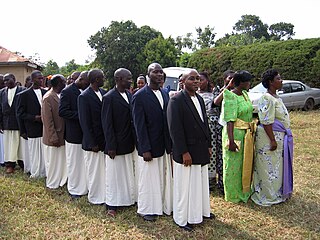
A kanzu is a white or cream coloured robe worn by men in the African Great Lakes region. It is referred to as a tunic in English, and as the Thawb in Arab countries. The kanzu is an ankle or floor length garment. It serves as the national costume of Tanzania as well as the Comoros, where it is called/pronounced 'Kandu' as well as thawb. The robe is also worn in some coastal Muslim regions of Tanzania and Kenya. The men of Uganda consider it their most important dress. Kanzu is a Ganda word of Swahili origin, which means "robe" or "tunic". In Tanzania, the term is used interchangeably with kaftan.

The boubou or grand boubou from the Wolof word mboubou is a flowing wide-sleeved robe from Senegal worn across West Africa, and to a lesser extent in North Africa.
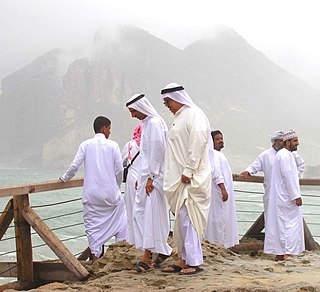
Thawb or thobe is an Arab dress for the inhabitants of the Arabian Peninsula, also called dishdashah, and kandurah, kandoora or gandurah in varieties of Arabic. A long-sleeved ankle-length traditional robe, it is mainly worn by men in the Arabian Peninsula, Jordan, Syria, Palestine, Lebanon, North Africa, and some countries in East and West Africa, with regional variations in name and style. It is also worn by Muslim men in the Indian subcontinent due to its modest appearance, and is referred to as jubbah. Depending on local traditions, a thawb can be worn in formal or informal settings; in the Gulf states thobes are the main formal attire for men. The term "thobe" is also used in some varieties of Arabic to refer to women's attire, such as in Palestine and Sudan.

Aso ebi (Yoruba), sometimes spelled as asoebi in Nigeria is a uniform dress or dressing code/style that is traditionally worn by the Yoruba People is an indicator of cooperation, camaraderie and solidarity during ceremonies, events and festive periods. The purpose of wearing the dress can be to serve as self-identification with age mates, relatives or friends during social occasions or funerals.

The fashion industry in Nigeria plays an important cultural role and contributes significantly to the country's economy. Clothing incorporates a variety of colours, fabrics, and embellishments. Many of the component cultures of Nigeria wear styles that are characteristic of their tribal society and customs. Nigeria produces fashionable textiles and finished garments and has designers who have achieved international recognition.
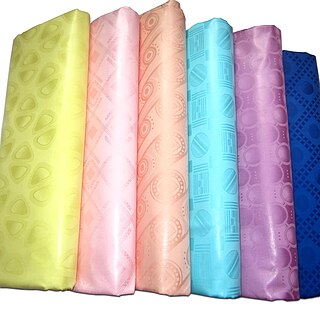
Bazin is a West African fabric with its origin in Europe imported in Mali, made from hand-dyed cotton, resulting in a damask textile known for its stiffness and vibrant sheen. It is primarily recognized as the most commonly used fabric for crafting a Boubou, a long, loose traditional outerwear worn by both men and women, particularly in West Africa.

Yoruba women’s clothing is the traditional attire worn by women of the Yoruba ethnic group in parts of Nigeria, Benin and Togo in a region called Yorubaland. The clothing reflects the rich culture, history and aesthetic preferences of the Yoruba people.























